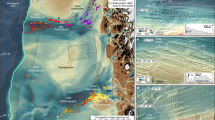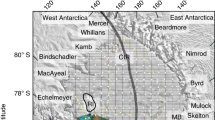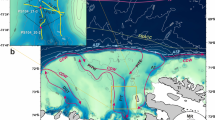Abstract
The bed of the West Antarctic Ice Sheet is, in places, more than 1.5 km below sea level1,2. It has been suggested that a positive ice-loss feedback may occur when an ice sheet’s grounding line retreats across a deepening bed1,2,3. Applied to the West Antarctic Ice Sheet, this process could potentially raise global sea level4 by more than 3 m. Hitherto, attention has focussed on changes at the Siple Coast5,6,7 and Amundsen Sea embayment8,9,10 sectors of West Antarctica. Here, we present radio-echo sounding information from the ice sheet’s third sector, the Weddell Sea embayment, that reveals a large subglacial basin immediately upstream of the grounding line. The reverse bed slope is steep, with about 400 m of decline over 40 km. The basin floor is smooth and flat, with little small-scale topography that would delay retreat, indicating that it has been covered with marine sediment5,11 and was previously deglaciated. Upstream of the basin, well-defined glacially carved fjords with bars at their mouths testify to the position of a former ice margin about 200 km inland from the present margin. Evidence so far suggests that the Weddell Sea sector of the West Antarctic Ice Sheet has been stable, but in the light of our data we propose that the region could be near a physical threshold of substantial change.
This is a preview of subscription content, access via your institution
Access options
Subscribe to this journal
Receive 12 print issues and online access
$259.00 per year
only $21.58 per issue
Buy this article
- Purchase on Springer Link
- Instant access to full article PDF
Prices may be subject to local taxes which are calculated during checkout


Similar content being viewed by others
References
Mercer, J. H. West Antarctic Ice Sheet and CO2 greenhouse effect: A threat of disaster. Nature 271, 321–325 (1978).
Joughin, I. & Alley, R. B. Stability of the West Antarctic Ice Sheet in a warming world. Nature Geosci. 4, 506–513 (2011).
Schoof, C. Ice sheet grounding line dynamics: Steady states, stability, and hysteresis. J. Geophys. Res. 112, F03S28 (2007).
Bamber, J. L., Riva, R. E. M., Vermeersen, B. L. A. & Le Brocq, A. M. Reassessment of the potential sea-level rise from a collapse of the West Antarctic Ice sheet. Science 324, 901–903 (2010).
Scherer, R. P., Aldahan, A., Tulaczyk, S., Kamb, B., Engelhardt, H. & Possnert, G. Pleistocene collapse of the West Antarctic Ice Sheet. Science 281, 82–85 (1998).
Anandakrishnan, S. & Alley, R. B. Stagnation of ice stream C, West Antarctica by water piracy. Geophys. Res. Lett. 24, 265–268 (1997).
Rose, K. E. Characteristics of ice flow in Marie Byrd Land, Antarctica. J. Glaciol. 24, 63–75 (1979).
Holt, J. W. et al. New boundary conditions for the West Antarctic Ice Sheet: Subglacial topography beneath Thwaites and Smith glacier catchments. Geophys. Res. Lett. 33, L09502 (2006).
Pritchard, H. D., Arthern, R. J., Vaughan, D. G. & Edwards, L. A. Extensive dynamic thinning on the margins of the Greenland and Antarctic ice sheets. Nature 461, 971–975 (2008).
Dowdeswell, J. A., Evans, J., Ó Cofaigh, C. & Anderson, J. B. Morphology of the continental slope off Pine Island Bay, Amundsen Sea, West Antarctica. Bull. Geol. Soc. Am. 118, 606–619 (2006).
Siegert, M. J., Taylor, J., Payne, A. J. & Hubbard, B. P. Bed roughness of the Siple Coast ice streams in West Antarctica. Earth Surf. Proc. Land. 29, 1591–1596 (2004).
Young, D. A. et al. A dynamic early East Antarctic Ice Sheet suggested by ice covered fjord landscapes. Nature 474, 72–75 (2011).
Bo, S. et al. The Gamburtsev Mountains and the origin and early evolution of the Antarctic Ice Sheet. Nature 459, 690–693 (2009).
Jankowski, E. J. & Drewry, D. J. The structure of West Antarctica from geophysical studies. Nature 291, 17–21 (1981).
Joughin, I. et al. Integrating satellite observations with modeling: Basal shear stress of the Filcher–Ronne ice streams, Antarctica. Phil. Trans. R. Soc. A 364, 1795–1814 (2006).
Joughin, I. et al. Basal conditions for Pine Island and Thwaites glaciers, West Antarctica, determined using satellite and airborne data. J. Glaciol. 55, 245–257 (2009).
Brunt, K. E., Fricker, H. A. & Padman, L. Analysis of ice plains of the Filchner–Ronne Ice Shelf, Antarctica, using ICESat laser altimetry. J. Glaciol. 57, 965–975 (2011).
Padman, L., Erofeeva, S. Y. & Fricker, H. A. Improving Antarctic tide models by assimilation of ICESat laser altimetry over ice shelves. Geophys. Res. Lett. 35, L22504 (2008).
Shepherd, A., Wingham, D. & Rignot, E. Warm ocean is eroding West Antarctic Ice Sheet. Geophys. Res. Lett. 31, L23402 (2004).
Nicholls, K. W., Østerhus, S., Makinson, K., Gammelsrød, T. & Fahrbach, E. Ice-ocean processes over the continental shelf of the southern Weddell Sea, Antarctica: A review. Rev. Geophys. 47, RG3003 (2009).
Shepherd, A. et al. Recent loss of floating ice and the consequent sea level contribution. Geophys. Res. Lett. 37, L13503 (2010).
Conway, H., Hall, B. L., Denton, G. H., Gades, A. M. & Waddington, E. D. Past and future grounding-line retreat of the West Antarctic Ice Sheet. Science 286, 280–283 (1999).
Jenkins, A., Corr, H., Nicholls, K., Stewart, C. & Doake, C. Interactions between ice and ocean observed with phase-sensitive radar near an Antarctic ice shelf grounding line. J. Glaciol. 52, 325–346 (2006).
Rignot, E. & Jacobs, S. S. Rapid bottom melting widespread near Antarctic ice sheet grounding lines. Science 296, 2020–2023 (2002).
Scambos, T. A., Bohlander, J., Raup, B. & Haran, T. Glaciological characteristics of the Institute Ice Stream using remote sensing. Antarct. Sci. 16, 205–213 (2004).
Holtedahl, H. Notes on the formation of fjords and fjord valleys. Geogr. Ann. 49, 188–203 (1967).
Rignot, E., Mouginot, J. & Scheuchl, B. Ice flow of the Antarctic Ice Sheet. Science 333, 1427–1430 (2011).
Pollard, D. & DeConto, R. M. Modelling West Antarctic Ice Sheet growth and collapse through the past five million years. Nature 458, 329–332 (2009).
Bentley, M. J. et al. Deglacial history of the West Antarctic Ice Sheet in the Weddell Sea embayment: Constrains on past ice volume change. Geology 38, 411–414 (2010).
Raymo, M. E. & Mitrovica, J. X. Collapse of polar ice sheets during the stage 11 interglacial. Nature 483, 453–456 (2012).
Acknowledgements
Financial support was provided by the UK Natural Environment Research Council AFI grant NE/G013071/1. C. Robinson (airborne survey engineer), I. Potten and D. Cochrane (pilots) and M. Oostlander (air mechanic) are thanked for their invaluable assistance in the field. D.Y. and D.D.B. were supported by the National Science Foundation ANT-0636724 and the G. Unger Vetlesen Foundation. We thank K. Brunt and H. Fricker for discussions regarding ICESat data and for providing an in-press copy of their recent work.
Author information
Authors and Affiliations
Contributions
M.J.S. and N.R. wrote the paper. M.J.S., F.F., N.R., R.G.B., H.F.J.C., T.A.J., A.L.B. and D.M.R. planned the aerogeophysical survey. N.R. and T.A.J. collected the data. N.R., H.F.J.C. and T.A.J. processed the data. D.M.R. and R.G.B. led the basal roughness analysis of the Institute and Möller ice streams. D.Y. and D.D.B. produced bed roughness analyses for the Siple Coast and Thwaites Glacier. A.L.B. provided glaciological information on MISI. All authors commented on a draft of the paper. M.J.S. and N.R. provided the geomorphic interpretation. M.J.S. and F.F. led the project.
Corresponding authors
Ethics declarations
Competing interests
The authors declare no competing financial interests.
Supplementary information
Supplementary Information
Supplementary Information (PDF 1061 kb)
Rights and permissions
About this article
Cite this article
Ross, N., Bingham, R., Corr, H. et al. Steep reverse bed slope at the grounding line of the Weddell Sea sector in West Antarctica. Nature Geosci 5, 393–396 (2012). https://doi.org/10.1038/ngeo1468
Received:
Accepted:
Published:
Issue Date:
DOI: https://doi.org/10.1038/ngeo1468
This article is cited by
-
Multiple episodes of ice loss from the Wilkes Subglacial Basin during the Last Interglacial
Nature Communications (2023)
-
Antarctic basal environment shaped by high-pressure flow through a subglacial river system
Nature Geoscience (2022)
-
Extensive retreat and re-advance of the West Antarctic Ice Sheet during the Holocene
Nature (2018)
-
Hard rock landforms generate 130 km ice shelf channels through water focusing in basal corrugations
Nature Communications (2018)
-
Choosing the future of Antarctica
Nature (2018)



